Park
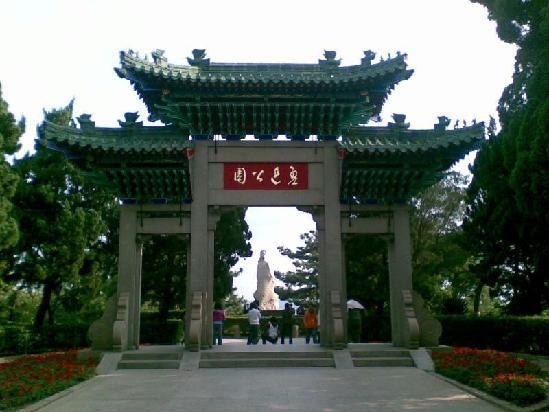
Lu Xun Park
Lu Xun Park Introduction
Lu Xun Park is two kilometers long stretching along the coast, neighbouring Qingdao Aquarium and No.1 Bathing Beach in the east. There are red reef, green water, pine, shadowed lane and pavilions with fascinating sceneries, featuring a scenic landscape with garden and natural beauty. Meandering scene and sights including red reef, green wave, pine and pavilions are very charming, as if another lane from the shore appeared when suspect way down the cliff.
In 1929, Mr. Ge Jingying, a famous Chinese horticulturist, built the park by the natural environment of sea and shore. During the first occupation of Japan, the black pine area had been built into a park, named Shu Bin Park, later renamed Haibin Park (seashore park) after the Chinese government recovered Qingdao. Before and after 1930, Qingdao Municipal Government began to build stone paving, construct pavilions and plant flowers in the park, which had been named Ruo Yu Park following the mayor’s name, then renamed Haibin Park (Seashore Park) and Haibin Park of Laiyang Road. In 1950, the park was named Lu Xun Park to commemorate Mr. Lu Xun.
Lu Xun Park is a free famous coastal attraction of Qingdao city. There is a Chinese classical stone arch in the main entrance of the park, in which the words Lu Xun Park are written and Peng Hu Lan Sheng are written by well-known Chinese calligrapher Zheng Shifen on the back of the arch. A granite statue of Lu Xun was built by donations of Qingdao youth in 1986, with a seal pool in the park. There are many red towering rocks, forming natural hills, gullies, cliff and seashore, fighting the waves with spectacular sceneries, while lanes, undulating nature, bridges, spilled water and winding streets are provided. Decorated by dense black pine, pavilion and aquarium, magnificent coastal scenery has come out, providing an ideal place for tourists to watch sea tide, enjoy coastal scenery and go fishing. The scenery of fishing around seashore was known as one of the ten views of Qingdao in the1930s.
Telephone number:0532-82868471
Address : South of Laiyang Road, Shinan District, Qingdao City
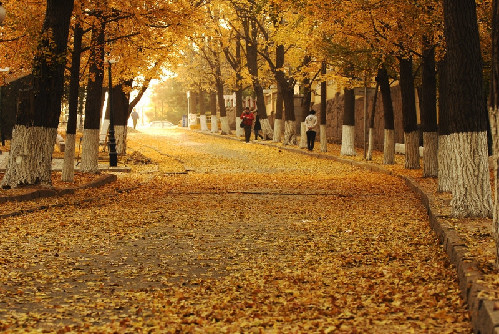
Badaguan (Eight Great Passes)
Lying between Huiquan Cape and Taiping Cape, Badaguan faces the rippling Taiping Bay. It covers an area of 67 acres, in which, ten roads were constructed in 1931. Some of the ten roads are planted with Chinese flowering crabapple, some with wisteria, some with white pines, some with gingkos and so forth. Eight of them are named after China's famous passes of the Great Wall, so this area is called Eight Great Passes. In spring and summer, tourists can appreciate gorgeous red flowers, while in autumn and winter, maples will give their performance in red dress. Badaguan is a well-known resort in China.
Badaguan is distinguished for being both parks and gardens, which gives the tourists a full view of green trees and flourishing flowers. Because more than 200 villas of exotic style stand among the flora and fauna, it is called a World Architecture Museum. It is honored as one of the five most fantastic places in China.
Address :Add: No.15 Zhanshansan Road, Qingdao
Mountain
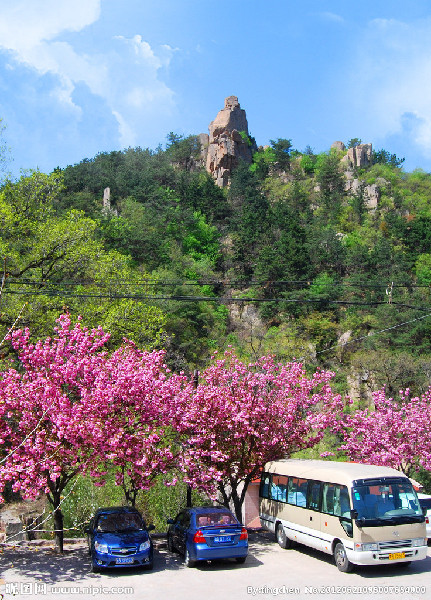
Laoshan Mountain
Laoshan Mountain is known as the “No.1 Mountain on the Sea.” It is situated on the coast of the Yellow Sea with a summit 1,133 m above the sea level. It stands by the sea with magnificent peaks, fantastic cliffs and clear streams and waterfalls. It has been known from ancient times as the“immortals’ abode” and “fairyland.” The chronicle book “Qi Ji” says: “The high Mount Tai is not as good as Mount Laoshan.” Qinshihuang, the first emperor of the Qin Dynasty and Emperor Wu of the Han Dynasty visited Laoshan. Emperor Xuanzeng of the Tang Dynasty assigned officials to come for elixir. Many scholars and celebrities visited here. Laoshan is also acclaimed as the“No. 2 Taoist Quanzhen Forest in the World” with 9 palaces, 8 temples and 72 nunneries. Laoshan Taoist priests are well known in history. Laoshan was affirmed by the State Council as a national key scenic area and by the Ministry of Forestry as a national forest park. There are three routes to Laoshan; the middle, southern and eastern routes. The Laoshan Scenic Area Administration Commission was founded in 1989. Its purpose is to protect, preserve and develop tourist resources. At present, the scenic area covers 446 km2, including 9 tourism areas and 5 restoration areas.
The tourism areas include Jufeng (summit), Liuqing, Shangqing, Taiqing, Chessboard Stone, Yangkou, North Jiushui, Hualou and Dengying. The landscape restoration areas are located in Shazikou, Wanggezhuang, Beizhai, Xiazhuang Villages, Xifu Town and land and sea scenery spots in surrounding areas. Southern, middle and eastern routes to Laoshan were opened in the recent years. The Taiqing, Yangkou and Hualou cableways have been completed and boat touring routes recently opened. Laoshan is now a famous scenic holiday area in China.
Address :Qingdao Mt. Laoshan area Haire road 178
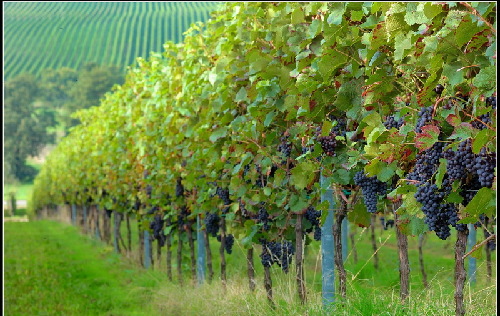
Daze Mountain Scenic Area
Daze Mountain, also known as “Jiuqing” Mountain, has been designated by the State as “Home to China’s Grapes,” “Northern China’s Quarry” and “Shandong Scenic Resort.” It enjoys abundant resources, beautiful scenery and a mild climate. It is a new tourist area and a “Civilization Model” for Shandong Province.
Daze Mountain lies in the eastern part of Shandong Peninsula at the northern border of Pingdu City. It extends for 324 km2 and includes 2,100 hills. The summit is 737 m above sea level, one of the highest peaks in the eastern Jiaozhou area. It is recorded in local chronicles that “streams coming from the mountains converge into rivers here, hence the name Daze (Big River).” Daze Mountain is full of magnificent ranges with a variety of pine trees, steep cliffs and secluded valleys. The chronicles say “the mountains and rivers are magnificent and secluded …….many hermits and celebrities lived here from the Qin and Han Dynasties, therefore it is known as “immortal’s abode.” After the Song and Jin Dynasties, more and more visitors came here. During the Ming and Qing Dynasties, the temples in the mountain became prosperous. More and more people came to see the sunrise and worship in the temples. During the Ming Dynasty, there was a saying that there were “thirty-six famous scenic spots on Daze Mountain,” and “Cloud in blue sky” was one of the eight famous scenes in Pingdu.
When touring the mountain, visitors come across steep cliffs, secluded valleys, high waterfalls and green forests as if traveling in a fairyland. In the Huangcheng scenic area, there is a northern peak and a western peak. The scenery on the northern peak is best. On Daze Mountain, there are beautiful peaks and cliffs everywhere in various shapes and formations. There are many legends about these areas such as: Sun Mo and Pang Juan studied in Guigu Cave; Xi Shi and Fan Li lived in seclusion in Fan Li Valley; Red Brow Army guarded Huangcheng County in the Han Dynasty; Prince Yang Si hid books in a case in the Sui Dynasty; and Emperor Li Shimin of the Tang Dynasty shot an arrow to get water. The story about militants in Gaojia Village using landmines to fight against Japanese troops during the War of Resistance against Japanese Aggression is well known in every household through the film “Landmine Battles.” Now, there is a memorial hall in Gaojia Village in memory of the landmine war.
Daze Mountain enjoys unique conditions for growing grapes, and there is a long history of grape cultivation here. There are historic records dating grape cultivation back to the Han Dynasty (2000 years ago). Daze Mountain is known as “Home to grapes.” The varieties produced here such as Rose Fragrant, Jufeng, Red Chicken Heat, Zexiang and Dragon’s Eye are superior in color, taste and shape. Visitors to Daze Mountain can enjoy both the picturesque landscape and delicious grapes.
Telephone number :0532-89635555 0532-85371359
Address :Daze Mountain
Amusement park
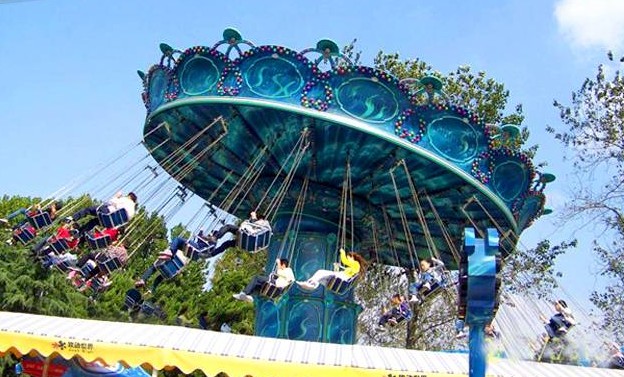
Qingdao Happy World Park
Qingdao Happy World Park has a total area of 35,000 square meters. It has been invested with 120,000,000 Yuan. The park is designed and constructed by the famous international design company Australia Xindaoxin Corporation using the concept of “Ocean in Motion.”
With its colorful ocean culture and free design concept, the park is devoted to building a happy kingdom, a paradise for mind and a harbor of relaxation for young people and modern urban families in the city center.Positioned in a large urban park, Qingdao Happy World offers a comprehensive tourism program for recreation, dining, shopping and relaxation.
Located in the Zhongshan Park, “Qingdao Happy World” has a unique geographic location with Taiping Mountain on its north, Huiquan Bay on its south and Badaguan on its west. The park integrates wonderful recreational facilities with the natural environment to form a beautiful and harmonious ecological environment.
Telephone number :0532-82870999
Address :28 Wendeng Road, Shinan District, Qingdao (inside Zhongshan Park)
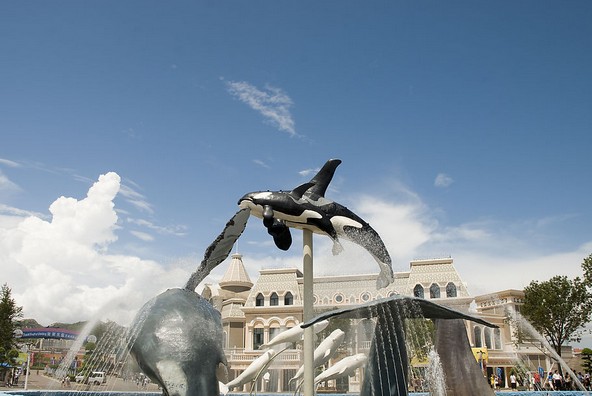
Qingdao polar region sea world
Qingdao Polar Ocean World was built by the Dalian Haichang Group with a total investment of USD 200 million. It covers an area of 200,000 m2, combining catering, accommodation, travel, tourism, shopping and entertainment. It is the largest tourist project in Shandong Province so far, and was one of the seven major projects for the 2008 Beijing Olympic Games.
Qingdao Polar Ocean World integrates the culture, history and natural resources of Qingdao to create an “Ocean Disneyland” and the first marine sleepless city. The first phase of the project was a modern structure in the shape of a boat. It has a floor area of 48,000 m2 and covers a land area of 30,000 m2. It is the first hyper sized polar ocean zoo in China and one of the best in the world. It has the largest number of marine animals and the most species of polar marine animals. It abandoned the traditional water tank for animal-raising. Instead, it adopts acoustic, video and electrical hi-tech aids to create a real polar marine environment that gives visitors the feeling of being in a real polar ocean world. There are special areas for popular polar science, scientific research equipment, culture and natural marina life. Visitors can experience a real polar research environment.
Qingdao Polar Museum will be the forerunner for the second generation of polar museums and will provide a special experience for the visitors.
Telephone number :0532-89091908/89091159
Address :Qingdao Mt. Laoshan area East China Sea east road 60
History
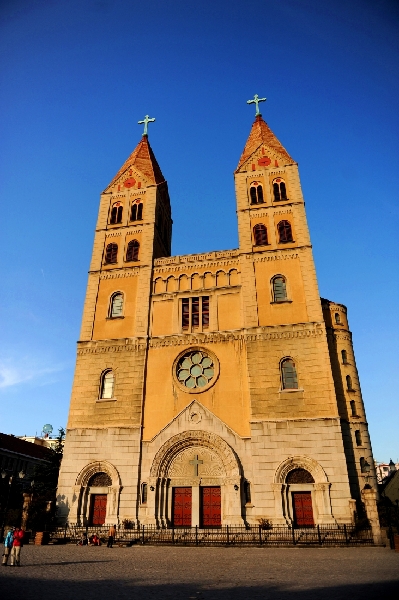
The Catholic Church
This Catholic Church is originally called St. Michael’s Cathedral, which was designed by a German architect Pepieruch in Gothic and Romanesque architecture styles. According the original design the church was supposed to be a hundred meters high. Due to the outbreak of World War II, Hitler prohibited the outflow of domestic funds. The church had to modify the design into the present scale.
The church was started to build in 1932, and was accomplished in 1934. The building covers an area of 11,480 square meters, of which the construction area occupies 6301.54 square meters. The church is built by yellow granite and reinforced concrete with the surface carved with simple and elegant textures. Windows were designed to be semi-circular arched with smooth lines, which together make them solemn and simple. Above the gate is a huge rose window, flanked by two clock towers on both sides. The tower is 56 meters high. Two 4.5 meters-high huge crosses erect on the cone shaped spires that covered by red tiles respectively. Four clocks are suspended in the towers and once the bells toll, the voice travels miles away. Stepping into the church, a bright and spacious lobby comes into view, which is up to 18 meters high and can accommodate as many as one thousand people. Soft light passes through the stained glass window. On both sides of the lobby there are corridors. At the back of it there are two big altars and four small ones. The dome is painted with saint fresco that highlights the strong religious atmosphere in the dazzling lights. The top of the church is covered with red tongue-like tiles—grand and exquisite. Decorations of the church adopt the Italian Renaissance form.
The bright and spacious lobby in the church is 18 meters high. Seven large chandeliers hang on the ceiling together with the altar at the back and the dome fresco exhibit the solemnity of the church.Catholic Church is the largest Gothic building in Qingdao with the capability of holding a thousand followers, the only consecrated church in China as well as a masterpiece of Christian architecture. During the Cultural Revolution, this church was seriously damaged. After several years of repair, it was re-opened in April 1981. It was listed as a key protected historic site at the provincial level.
Telephone number :0532-82865960
Address :15 Zhejiang Road, Shinan District, Qingdao, Shandong Province
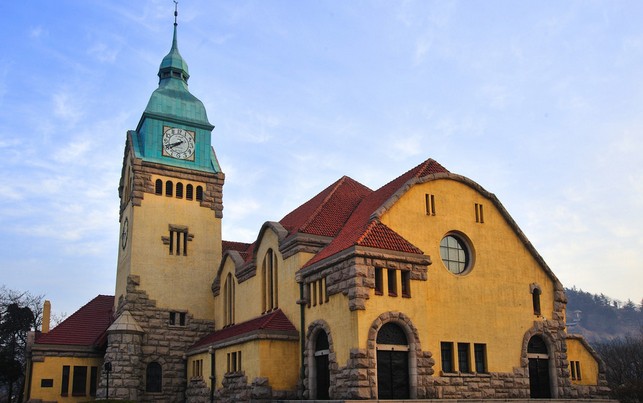
The Lutheran Church
The Lutheran Church Introduction
The Lutheran Church is a famous religious building of Qingdao and a major historic and cultural site under provincial protection, which is located on a hill at 15 Jiangsu Road in Shinan District of Qingdao, with beautiful Signal Mountain Park nearby to the east. It was invested by German Kiaochow governors’ office, started on April 19, 1908 and completed on October 23, 1910.
There is a bell tower on the top of it with a height of 39.1 meters, commonly called “Clock Tower”. It is a typical German Castle building covering 1000㎡ and featured with a bell tower and an auditorium. The bell tower is 39.01m high, on top of which tourist can get a view of the picturesque seascape. The big clock on the bell tower gives the solemn church more mystery and decency. The auditorium is spacious and bright and can hold thousands of people. The auditorium of 18 meters high consists of upstairs and downstairs. Decorated very exquisitely and elegantly, it gives people a feeling of sanctity as people in it. It is no doubt a perfect work of Christian architecture.
There are two two-story buildings in the church yard. One is ancillary church, and the other is the residence of preachers. The square in front is flat and broad with trees and many kinds of western buildings around, which further set off the church’s magnificence. Distant mountains, nearby trees, green ceilings and yellow walls are looming in the morning mist at dawn, which makes you feel like in an exotic land at this moment. As people walk up on the narrow steps of stone hill, the church’s solid and thick wall, half-circle and arched granite window frames, sloping red roofs and green-spire bell tower come into view. The foundation made of thick granites is dignified and rough, which outlines the church clear and concise and adds an aesthetic feeling characteristic of religious building.
Telephone number :0532-82865970
Address :15 Jiangsu Road, Shinan District, Qingdao
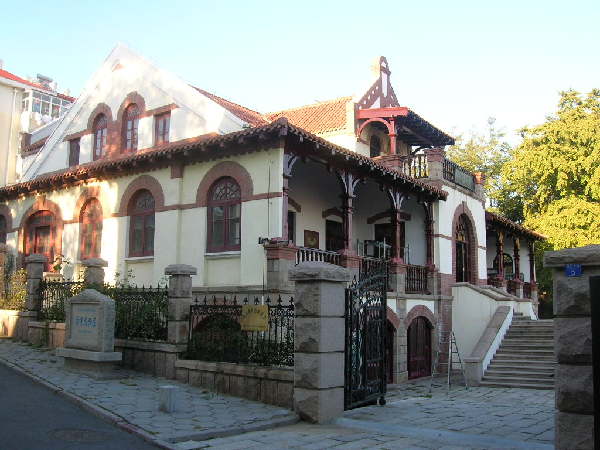
The Memorial Hall of Kang Youwei's Former Residence at Qingdao
Kang Youwei's Former Residence, also called Tianyou Garden, located at 5 Fushan Branch Road, is a German styled three-storey brick and concrete building originally constructed in 1899, covering a total floor area of 1,128 square meters. During the German occupation of Qingdao, this building was the official residence for the important officials of German Praetorium.
In 1917, after participating in the Restoration (1917) launched by Zhangxun and ended in failure, Kang Youwei came to Qingdao for sightseeing for the first time. Short as his stay was, the city left him an excellent impression. In the letter to his friend afterwards, he credited Qingdao as a city with “afforested mountains and green trees, blue sea and azure sky, agreeable climate and convenient transportation on both land and at sea, which can be hailed as the best in China.” In 1923, Kang Youwei purchased this house when he came to Qingdao again. He was so satisfied with the residence that he said: The house in Qingdao is so nice that I have never had one like this before in my life,” “although the house is small, the courtyard is very big. Within only a few minutes’ walk I can get to the sea. Since Puyi, the last emperor of Qing dynasty, had presented him with a horizontal inscribed board on which the Chinese characters Tianyou Hall were inscribed, he named his residence Tianyou Garden (Heavenly Pleasure Hall). After that, he came to live here for a while every year, meeting cultural celebrities and devoting himself to calligraphy, until he passed away in Tianyou Garden on March 31, 1927.
The building covers an area of 1,128 square meters, and is mainly made of bricks and wood. The furnishings were bestowed by Puwei, Prince of Gongqin, the 2nd generation of princes in the Qing Dynasty. During his stay, Kang Youwei met the cultural celebrities, and devoted himself to calligraphy, thus making the building famous home and abroad. Tianyou Garden, Kang Youwei’s former residence, which is located at 5 Fushan Branch Road, Qingdao, contains some old belongings and works of Kang Youwei, one of the main leaders of the Reform Movement of 1898 in the modern history of China. Chairman Mao considered that Kang Youwei was the representative of those who sought truth from the western culture before the foun ding of our Communist Party of China.
At present, the residence is built into the Memorial Hall of Kang Youwei's Former Residence. Tianyou Garden remained her original look after the new China was founded, but it was changed into civilian residences, and the yard was already different from the former garden. In 1984, the Qingdao Municipal Government decided to build a Memorial Hall of Kang Youwei's Former Residence at the original site of Tianyou Garden. After several years’ preparation, some residents were transferred away, and the first two floors were officially open to the public, as the Memorial Hall of Kang Youwei's Former Residence. The graveyard of Kang Youwei is located “by the green forest, under the mountain ranges, above the blue sea, among the beautiful flowers”, the epitaph of which was written by Master Liu Haisu, one of Kang’s students. Lots of people come here to visit and express their respect continuously. Having witnessed a century of vicissitude, the Memorial Hall of Kang Youwei's Former Residence is now an important cultural palace of Qingdao, a city famous for its history and culture, and it is especially meaningful to understand the Chinese modern history and the cultural connotation of Qingdao. The hall is now a key historic site protected at the provincial level, as well as Shandong Provincial Base for Patriotic Education.
Telephone number :0532-82879957
Address :5 Fushan Branch Road, Qingdao

Zhanqiao Pier
Zhanqiao Pier is the symbol of Qingdao. It was called Qianhai Pier, Nanhai Pier and Big Dock. Located in the Qingdao Bay, it is the extension of Zhongshan Road, the busiest commercial street in Qingdao. It is acclaimed as “a long rainbow on the sea”. It was initially built in 1892, and was the first dock in Qingdao. It was rebuilt in 1931 and renovated in 1985. It is now 440 meters long and 8 meters wide. There is a semicircle breakwater at the southern end, and within the breakwater, there is two-storey eight-cornered pavilion with golden roof and red wall. This is the famous “Huilange”(Wave Pavilion).
Zhanqiao Pier looks like a dragon on the sea. Walking on it towards the southern end, you feel as if you are entering the sea. Standing by the pavilion, you can see the waves coming with great force and splashes on the breakwater, with drops of water flying like pearls.
Coming into the pavilion, and climbing to the top floor through the spiral stairs, you can see the sea on all sides. At this time, you will be convinced that Huilange is indeed one of the ten major scenes in Qingdao. In Autumn, when the tide rises, the scene at the west of the pavilion is the best, with the 10 meter waves splashing on the breakwater with great sounds. Simply splendid! When the tide ebbs, there are lots of people on the intertidal zone, digging clams. In the recent years, people organized “retain the seagull” campaigns. At the junction of autumn and winter and during windless days, you can see thousands of seagulls flying over Qingdao Bay, forming a picturesque panorama with the sea, the blue sky, the pavilion and the people.
The north coast of Zhanqiao is now a park called Zhanqiao Park. There are pine trees, lawns, and stone benches. In the night, the lamps in the streets and Zhanqiao are like beautiful flowers, and the light from the lighthouse on Mini Qingdao is reflected by the sea water, giving a fantastic atmosphere to the visitors. Zhanqiao Pier is also a landmark and famous tourist spot in Qingdao.
Telephone number :0532-82884548
Address :No.12 Tainping Road, Qingdao
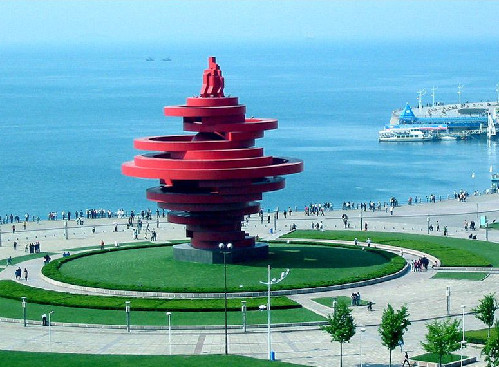
May 4th Square
May 4th Square is named to honor the May 4th Movement which took place in 1919, and it is the core of the Sculpture Street on Donghai Road. On the north-south axis of the square are situated the City Hall, the concealed spring, the array spring, the lawn, the parterre, the symbolic sculpture “the Wind of May”, and the marine hundred-meter spring, contributing to the modern metropolitan scene with energy and magnificence.
The large-side steel structure sculpture “the Wind of May” spiral upwards, which looks like a light breeze, fully embodies patriotism and Chinese national cohesion of anti-imperialism and anti-feudalism in the May 4th Movement. The whole square is decorated with statues and springs, and surrounded by pine trees, meadows and flowers, featuring vigor, elegance and grandeur, typical of Qingdao character and time spirits. A symbol square of Qingdao, it is for assembly, recreation, entertainment, tours, sightseeing, etc.
Telephone number :0532-83886355
Address :Add: No.24 Donghai W. Road, Qingdao
Museum
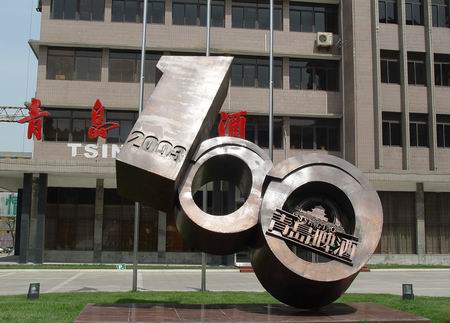
Qingdao Beer Museum
Qingdao Beer Museum is located in the Tsingtao Beer Brewery at 56 Dengzhou Road. Built in 1903, it combines historical treasures with modern design. It has a floor area of 6,000 m2 and was completed and opened to the public on August 15th, 2003. The old German building and equipment are an important part of company culture.
The museum describes the history of the Tsingtao Beer Brewery, its profound culture and advanced technology, and integrates beer entertainment and shopping. The museum was invested with 40 million RMB. It is the first and only beer museum in China, and the first of its kind in the world. It has three main areas: the history of a century and culture area, production technology area, and multi-function area. It takes one hour to tour the museum. In 2004, the museum was listed as the first industrial tourism demonstration unit. In 2005, it was designated as a national AAAA tourist spot. In 2006, it was listed as a national key cultural site under national protection. In 2007, it became one of the first famous tourist sites in Qingdao.
Telephone number :0532-83833437
Address :56 Dengzhou Road, Qingdao